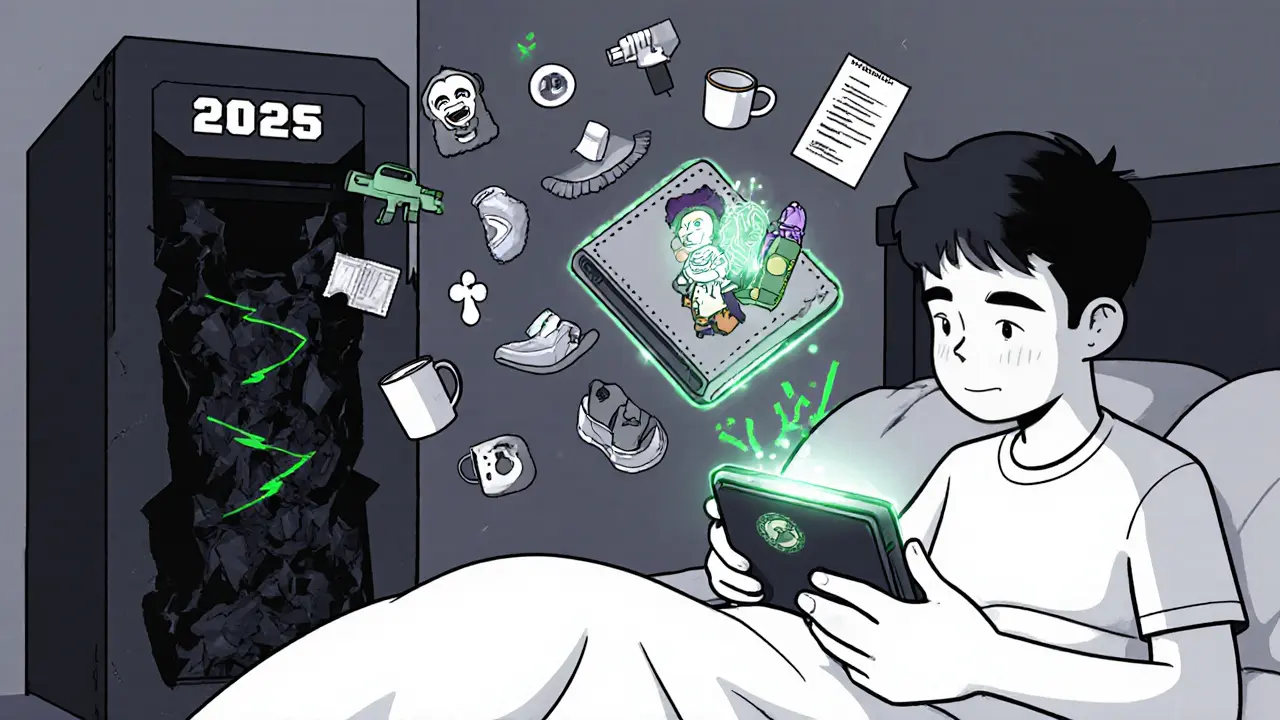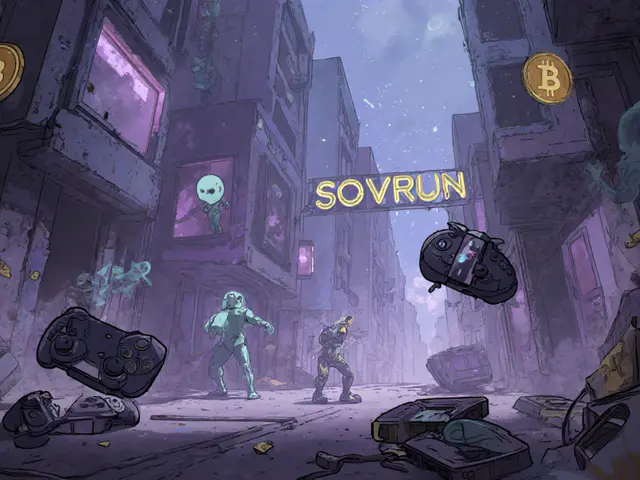Play-to-Earn Earnings Calculator
Input Parameters
Calculator Results
Monthly Earnings
After transaction costs: $0.00
Based on 2025 average data (68% of players cite true ownership)
ROI Analysis
Return on investment: 0.00%
How This Relates to the Article
Real Data Reference The Philippines player earning $350/month (14.3M monthly players)
Economic Insight 68% of players stay due to true ownership (vs. 32% for traditional gaming)
Risk Factor 98% of token-based games collapsed due to unsustainable models (Star Atlas example)
By 2025, blockchain gaming isn’t just a niche experiment-it’s the most accessible way millions are entering the world of cryptocurrency. You don’t need to understand smart contracts or gas fees to start playing. You just need a phone, a few minutes, and the curiosity to see if your time spent killing monsters or building cities can actually pay your internet bill. That’s the real shift: blockchain gaming turned entertainment into economic participation.
True Ownership: Your Items Aren’t Just Locked in a Game
In traditional games, you buy a skin, a weapon, or a rare character. But you don’t own it. The game company can delete it, ban you, or shut down the server-and your $50 is gone. Blockchain gaming flips that. Every item you earn or buy is a real digital asset stored on a public ledger. It’s not tied to one game. It’s yours. You can sell it on OpenSea. Trade it on a peer-to-peer marketplace. Even rent it out to other players. This isn’t theoretical. In 2025, over 14.3 million people worldwide play blockchain games monthly, and 68% say true ownership is why they stick with it.The Metaverse Isn’t Just VR Headsets
When people talk about the metaverse, they picture sci-fi goggles and floating islands. But the real metaverse is already here-and it’s in your pocket. It’s the player in the Philippines earning $350 a month playing Splinterlands, enough to beat the local minimum wage. It’s the teenager in Brazil trading virtual land on Decentraland, where LAND parcels now average $2,850. It’s the group of friends in Mexico using Roblox-like worlds to hold virtual meetings, complete with digital offices and branded storefronts. The metaverse isn’t one place. It’s a network of interconnected digital spaces where identity, economy, and social life blur.How It Works: No Magic, Just Code
Blockchain games run on decentralized networks-mostly Ethereum Layer 2 chains like Polygon, or Solana-where game rules and item ownership are written into smart contracts. These are self-executing codes. If you win a rare sword, the contract automatically transfers it to your wallet. No middleman. No delays. No company deciding you’re “not allowed” to sell it. Transactions are fast: modern blockchain games now handle 15-30 transactions per second, up from just 3-6 in 2022. That’s not as fast as Fortnite’s servers, but it’s enough for trading, crafting, and battling without constant lag.
Play-to-Earn: Real Money, Real Risks
The biggest draw? Earning while you play. Games like Alien Worlds let you mine tokens just by logging in daily. Axie Infinity once had players making over $1,000 a month. But here’s the catch: most of those high-earning games collapsed. Why? Because they were built on unsustainable token inflation. The game paid you in its own coin, but didn’t create real demand for it. When new players stopped joining, the coin crashed. Star Atlas lost 98% of its value. Only 22% of blockchain games launched between 2021 and 2023 still have viable economies today. The winners? Games that balance rewards with real utility-like using tokens to buy land, upgrade gear, or vote on game updates. The best projects now tie earnings to actual gameplay, not just hype.Mobile Is Winning, Not VR
Forget needing a $500 headset. The future of blockchain gaming is mobile. In 2025, 67% of all blockchain gaming activity happens on phones. Why? Because you don’t need a gaming PC. You don’t need to learn how to connect a wallet to MetaMask. Apps like Treasureland and My Pet Hooligan are designed like casual games-tap, collect, level up. The wallet setup? Still clunky. 73% of negative reviews mention confusing wallet connections. But developers are fixing it. New onboarding flows now walk users through setup in under 5 minutes. Some even let you start playing without a wallet at all, then prompt you to link one later.Big Players Are Watching
Epic Games, maker of Fortnite, launched a blockchain-agnostic platform in January 2025. It doesn’t force NFTs. It just lets developers add them if they want. Roblox rolled out limited blockchain integration for virtual land ownership. Microsoft’s Mesh and NVIDIA’s Omniverse are building tools for businesses to create metaverse workspaces. These aren’t crypto evangelists. They’re corporations seeing real user behavior: people want to own what they create. And they’re willing to trade, sell, or invest in it. The metaverse isn’t coming-it’s being built by gamers, not tech CEOs.The Learning Curve Is Still Steep
If you’ve never used crypto before, getting started feels like assembling IKEA furniture without the instructions. You need to understand seed phrases, gas fees, wallet security, and exchange transfers. A 2025 study of 5,000 new users found 62% needed outside help just to complete their first transaction. 28% had failed transactions because they didn’t have enough gas. 17% of compromised accounts came from phishing scams. But the community is stepping up. Top blockchain games now have Discord servers with 200,000+ active members. Tutorials on YouTube and Reddit are better than ever. The barrier is lowering-but it’s still there.What’s Next? Integration, Not Explosion
The next big wave won’t be another “next-gen” blockchain game. It’ll be subtle. You’ll play a regular mobile game, and suddenly, you can choose to earn tokens instead of just XP. Your in-game item might be listed on a marketplace. Your avatar could carry assets from another game. DAO governance will let you vote on new maps or item drops. By 2027, experts predict 10% of global GDP will be stored on blockchain-and gaming will be the biggest contributor. The World Economic Forum sees this not as a revolution, but an evolution. The metaverse isn’t about flashy tech. It’s about giving people control over their digital lives.Will This Last?
Yes-but not the way you think. The wild speculation of 2021 is over. The “get rich quick” NFT games are dead. What’s left are projects focused on real utility: play, own, earn, trade. The companies surviving are the ones building ecosystems, not just tokens. The players winning are the ones treating it like a side hustle, not a lottery ticket. And the platforms that win? Those that make blockchain invisible-so you just play, and the ownership happens in the background.The future of blockchain gaming isn’t about digital gold mines. It’s about digital freedom. You’re not just playing a game anymore. You’re building something that belongs to you-and that changes everything.


ty ty
So let me get this straight-you’re telling me I can now get paid to click on pixels instead of my actual job? Brilliant. The only thing more absurd than this is the fact that people actually believe it’s sustainable.
BRYAN CHAGUA
This is a genuinely thoughtful breakdown of a complex shift in digital economics. The move toward true ownership isn’t just about tokens or NFTs-it’s about recognizing that digital labor, creativity, and time have real value. The fact that millions are already using this to supplement their income, especially in developing economies, shouldn’t be dismissed as a fad. It’s a quiet revolution.
Ashley Mona
I love how the mobile-first approach is finally making this accessible! 🙌 I showed my 70-year-old aunt how to play Treasureland last week-she’s now earning enough crypto to buy her weekly groceries. The wallet setup still gives people anxiety, but the tutorials are way better than they were two years ago. It’s not perfect, but it’s growing. And that’s what matters.
Diana Dodu
America built the internet. America built the gaming industry. And now some guy in the Philippines is making more than me playing a game on his $200 phone? No. No. NO. This isn’t progress-it’s a betrayal of the American dream. We’re outsourcing our future to crypto bros who don’t even pay taxes.
Raymond Day
OMG!!! I just found out my virtual sword from Axie Infinity is now worth $12k on OpenSea!!! 😱🤯 I cried. I screamed. I posted it on TikTok. I got 2M views. My dog now has a digital collar. I’m rich. The government is coming for me. I’m moving to El Salvador. #NFTlife #BlockchainIsTheFuture #SendHelp
Noriko Yashiro
I think this is amazing really. People in places like the Philippines and Brazil are using these games to survive. I mean, come on-minimum wage is $200 a month there. If you can earn $350 playing a game on your phone? That’s not a game. That’s survival. And honestly? I think we should be cheering for that, not mocking it.
Atheeth Akash
Interesting read. I play a blockchain game on my phone while commuting. It’s not about the money. It’s about the community. The Discord group I’m in has people from 12 countries. We help each other with wallet issues. We share tips. It feels like something real. Not like other games where everyone just screams and rage quits.
James Ragin
Let’s be clear: this isn’t about ownership. It’s about the Federal Reserve’s collapse. The Fed has been printing money since 2008. Now they’re using blockchain gaming as a Trojan horse to replace the dollar with algorithmic currency. The metaverse is the new surveillance state. They want you to think you’re owning something-but you’re just feeding data to the same banks that crashed the economy in 2008. Wake up.
Michael Brooks
The real win here isn’t the money-it’s the fact that you can take your digital stuff with you. In regular games, you spend hundreds on skins, and if the server shuts down? Gone. Forever. But with blockchain? That sword you spent 6 months grinding for? You can sell it, trade it, even lend it. It’s not magic. It’s just code that respects your time. That’s huge.
David Billesbach
You think this is freedom? It’s a Ponzi scheme dressed up as a game. The only people making money are the devs who minted the first 10% of tokens. Everyone else is just the sucker who buys high and gets dumped on. And don’t even get me started on the ‘utility’-you can’t even use your token outside the game unless you’re willing to risk your entire life savings on a crypto exchange. This isn’t innovation. It’s digital gambling with better marketing.
Laura Hall
I used to think this was all hype until my little brother, who’s autistic and barely talks to anyone, started playing a blockchain game and made friends from Japan, Poland, and Nigeria. He talks about his virtual farm like it’s real. He saved up enough to buy a new skin-and he’s so proud. I didn’t realize how much this kind of space could help people feel seen. It’s not about the money. It’s about belonging. And honestly? That’s worth more than any NFT.